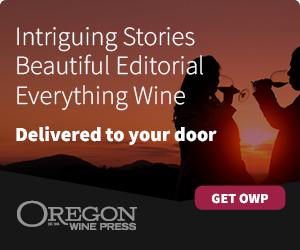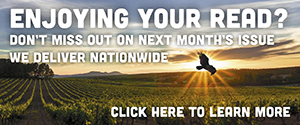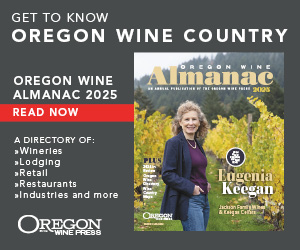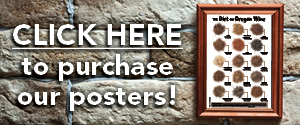Riddling Revolution
Oregon sparkling wine made using the traditional method grows more popular
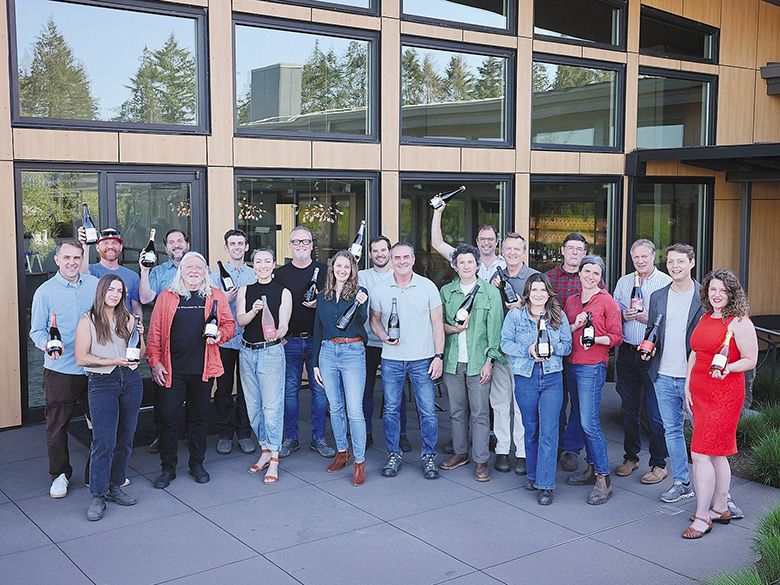

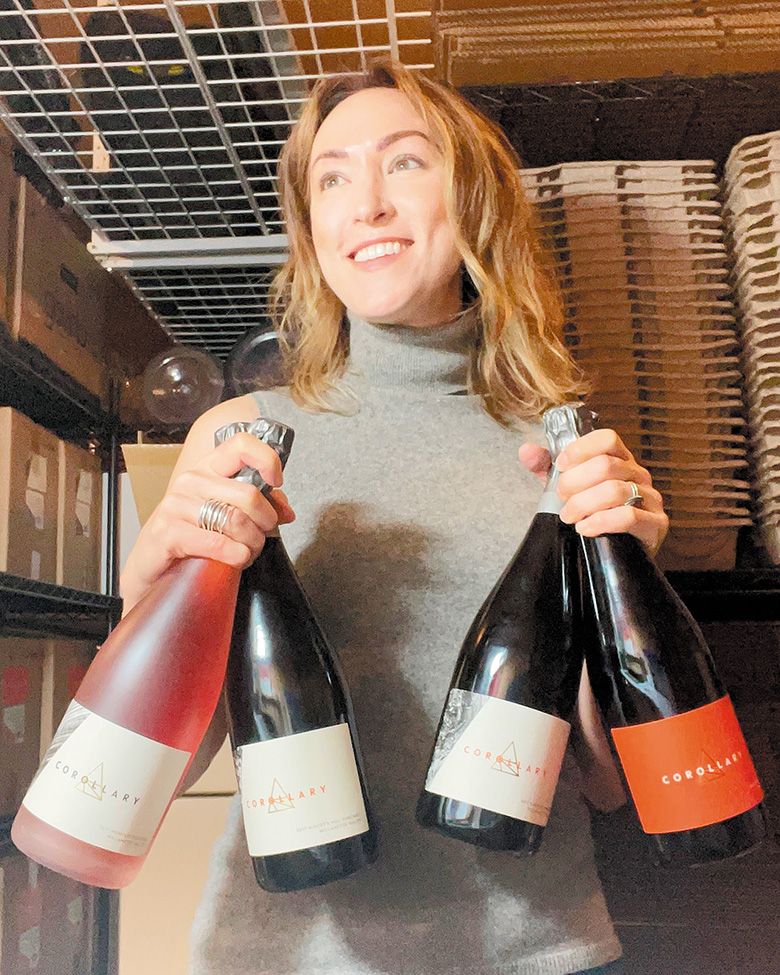
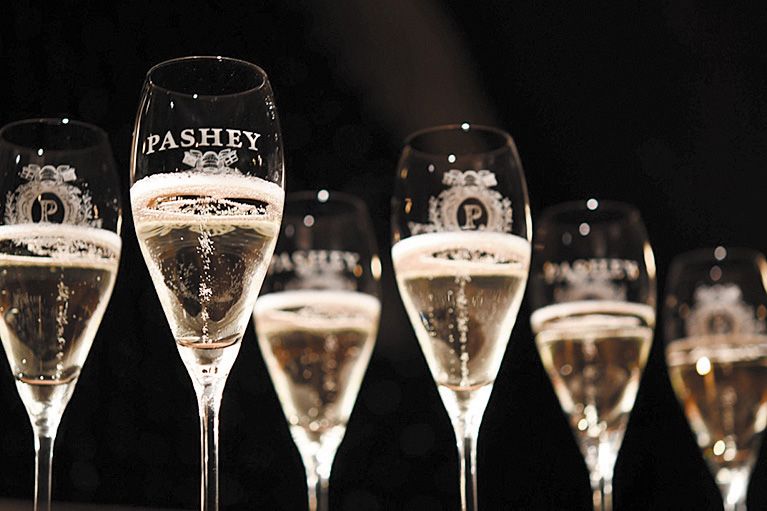
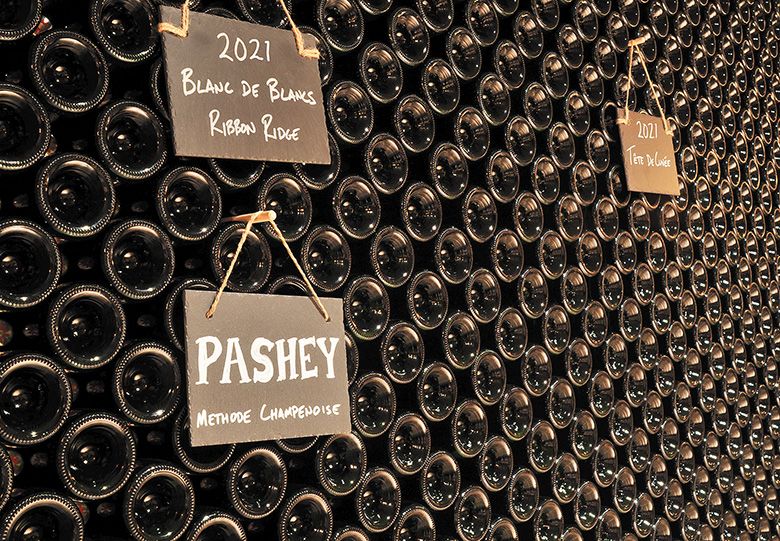
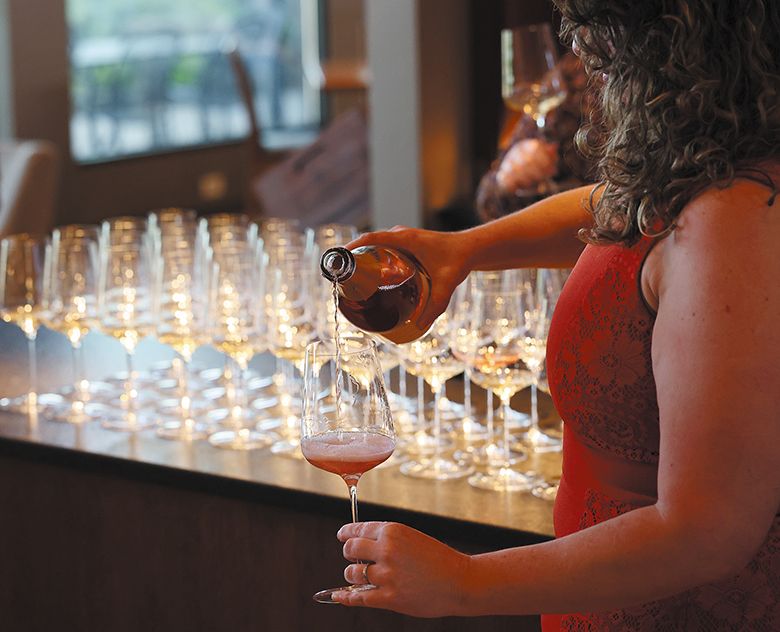
By Sarah Murdoch
Queen Elizabeth II, who lived to 96, enjoyed a nightly glass of Champagne before bed. She preferred Bollinger Champagne, ushered into the monarchy in 1884 by her great-grandmother, Queen Victoria, more than 14 decades ago.
In 2021, Oregon wine became part of Champagne history when Groupe Bollinger bought Ponzi Vineyards in Sherwood. Their first property acquisition outside France, this endeavor infused new life and opportunity to the winery, and considerable excitement to Oregon wine. Not to mention the fact the Champagne House (founded in 1829) could have invested anywhere on the planet. Yet, they, like many consumers today, chose Oregon.
While we can’t call Oregon-produced sparkling “Champagne” because it’s not made in Champagne, France, its closest sibling is traditional method sparkling wine. It’s worth noting: Oregon is ideal for growing the holy trinity of grapes typically blended for sparkling: Pinot Noir, Chardonnay and Pinot Meunier.
Happily, sales are popping, too. At last count by the annual Oregon Vineyard & Winery Census commissioned by the Oregon Wine Board, more than 478,000 cases of Oregon sparkling wine were sold in 2023. This is a barnstorming increase of over 107 percent from the previous year.
While it’s been called a movement, a renaissance, a revolution even, consumer interest in Oregon sparkling hasn’t been meteoric. In 1979, the late Fred Arterberry, Jr. launched “Red Hills Brut” and “Sparkling White Riesling,” the first Oregon-made sparklers crafted in the traditional method. The Dundee Wine Company (now Argyle Winery) opened 17 years later, in 1987, by Brian Croser and Cal Knudsen. Rollin Soles was the founding winemaker.
In a recent Capital Press article, Soles told writer Kyle Odegard, “We always felt like one hand clapping in the woods because nobody else was showing up to make sparkling wines.”
R. Stuart & Co. Winery’s winemaker Rob Stuart confirms this sentiment; “There has been a change in the last 10-15 years. Folks have increased interest in Oregon sparkling and are no longer comparing us against French Champagne. I'm delighted that people are simply enjoying it now.”
“Demand has certainly grown since 2018, when we first released the sparkling wines nationally,” said Shane Moore, Gran Moraine’s winemaker. “At that time, Willamette Valley sparkling wine wasn’t really a category buyers were comfortable putting on their wine lists. Now they have a place.”
Sparkling comprises about 30 percent of the Yamhill winery’s portfolio by volume. “Gran Moraine has been slowly and deliberately creating additional wines, including a new vintage-dated Blanc de Noir. We plan to release the 2022 in fall of 2026,” shares Moore.
No matter how long it’s taken, traditional method sparkling— with a uniquely Oregon flavor profile— is gaining an enthusiastic following. In fact, a group of producers focused on elevating Oregon traditional method as a category, and christened it simply “Method Oregon.”
Jeanne Feldkamp, co-owner and co-winemaker for Corollary Wines in Amity, noted, “Our state’s unique geography delivers freshness, acidity and a distinctively Oregon fruit profile ideal for the long aging required by traditional method production.”
What exactly is traditional method?
Traditional method sparkling, aka méthode traditionnelle or méthode champenoise, entails two fermentations: the first in barrel or tank, and the second within each individual wine bottle. After the second fermentation, the wines rest for months– sometimes even years– in contact with the lees (sediment primarily composed of expired yeast cells). Called by the French term “en tirage,” the process results in complex layers of flavor and texture in the sparkling wine.
Before a traditional method wine can be sold, each bottle must undergo riddling, a sequence of rotations and slow tilting to draw the lees and sediment into the neck. The process is complete only after each bottle is upside-down. Next, the wine needs to be disgorged by quickly flipping the bottle upright while simultaneously popping the crown cap. The pressure from the bubbles inside forcibly expels the sediment. A small amount of dosage– a blend of wine and sugar– is added before each bottle is corked and labeled.
Twenty-two wineries producing traditional method sparkling will gather in Dayton on July 26 for the inaugural Method Oregon Grand Tasting hosted by Domaine Willamette. All featured wines will be Oregon-made traditional method bubbles, with a minimum of 15 months of tirage aging.
Sparkling wine enthusiasts can attend a panel discussion held before the Grand Tasting. Soles, who left Argyle in 2003 to found ROCO Winery in Newberg with wife Corby, will be joined by Andrew Davis, founder of The Radiant Sparkling Wine Company (recently purchased by Vinovate Custom Wine Services); and Kate Payne Brown, head winemaker at Argyle Winery. They will discuss the evolution of Oregon sparkling wine, its anticipated journey and continuous industry innovations. Award-winning wine writer, speaker and consultant Julia Coney will moderate the panel.
Andy Lytle, founder of Lytle-Barnett in Dundee, regards Method Oregon as a platform for evangelizing sparkling superfans. “We’ve long been focused on elevating Oregon traditional method as a category everyone should be paying attention to, and we’re happy to see so many people discovering the world-class wines from our region.”
Sparkling can be found as far south as the Rogue Valley, home to Maison Jussiaume, and as far east as Milton-Freewater, where Los Rocosos crafts one made from estate Sangiovese. Also, in Milton-Freewater, Toby Turlay, Ducleaux Cellars’ co-winemaker (who worked harvest with Chandon in Napa) plans to release a traditional method sparkling from estate Marsanne and Roussanne next year.
What’s creating the demand for Oregon sparkling wine?
Reason 1: Traditional method sparkling is made by skilled craftspeople
With four wines, including two sparklers, ranked 90+ in Wine Spectator’s June 2025 issue, Dundee winery Argyle is experiencing its own renaissance. Adding to Argyle’s recent excitement is the appointment of Kate Payne Brown, the producer’s third winemaker in 38 years.
Argyle’s hospitality manager Ryanne Robinson enjoys witnessing customers’ enthusiasm, especially “when they return from traveling in France. Many have encountered the term ‘méthode traditionnelle’ while abroad, but they better understand after we explain it. When we walk them through our process– especially with our Extended Tirage– they recognize our craftsmanship and pricing. It really clicks in a way it doesn’t always overseas, because we’re speaking their language and showing them firsthand."
Andrew Davis, another skilled craftsperson with roots at Argyle, helped start the wave of traditional method sparkling programs around the Willamette Valley. McMinnville’s The Radiant Sparkling Wine Company has allowed clients to craft some of the highest-scoring wines in Oregon history. Michael Mega, founder and winemaker of Nysa Vineyard in the Dundee Hills, explains, “Andrew is the best in the business and his facility is an easy answer to disgorging. Since he is also a friend, his advice is invaluable.”
Radiant was the first company in Oregon dedicated to supplying winemakers with the specialized equipment and services necessary to craft traditional method sparkling wine. Notes Willamette Valley Vineyards’ founder, Jim Bernau, “Andrew has helped many Oregon winemakers with our sparkling wine production. Having him here in Oregon has been a critical piece of the puzzle.”
Reason 2: It’s made in small batches with attention to detail
Because Oregon sparkling wines are made in such limited quantities, winemakers can dedicate more time and care to each bottle, developing richer, more unique flavors.
Willamette Valley Vineyards owns and manages over 1,000 acres across twelve estate vineyards. Last year, the winery made over 250,000 cases of wine. Yet, their biodynamically farmed vineyard and sparkling winery Domaine Willamette produced only 2,000 cases of méthode traditionnelle sparkling wine– less than one percent of its production.
Terry Culton, Willamette’s director of winemaking and vineyards, intends to make a fully biodynamic sparkling wine with some of the elements of traditional winemaking. He explains, “Most premium producers follow classic méthode champenoise winemaking techniques for sparkling wines with the traditional varietals of Pinot Noir, Pinot Meunier and Chardonnay. However, we're considering Pinot Blanc and Pinot Gris in future blends. Experimentation is exciting and can pave the way for upcoming generations.”
Wineries producing small amounts of sparkling wine, like Nysa Vineyard, are gratified to discover their bubbly can represent a gateway for people. Notes Mega, “Offering a sparkling wine has definitely put us on some people’s radar.” Is there more to come? “Yes, we plan to disgorge our 2019 Oregon Blanc de Noir this fall and still have some 2017 en tirage until 2027.”
Similarly, Tristen Frey of Trisaetum, in the Ribbon Ridge appellation, states, “Our sparkling brand Pashey has become crucial, accounting for about 20 percent of our portfolio since its launch in 2014. Most visitors begin with a taste of Pashey and events like Method Oregon raise awareness, creating additional demand for sparkling wine.”
Gaston’s Elk Cove Vineyards has expanded its sparkling production over the past decade, adding both a single vineyard brut and Blanc de Blancs. Yet, it’s less than one percent of their portfolio, reports Anna Campbell, Elk Cove’s co-owner and creative director. “Our brut rosé is the highest volume at 400 annual cases and makes its way to small wine shops and restaurants with superb wine lists.”
On a similar note, Ponzi Vineyards’ sparkling program delivers a premium price, says Carrie Kalscheuer, chief brand officer. “We began including sparkling wine in our highest-end club offerings with notable results. Not only are we getting more sign-ups but also seeing people add additional bottles to their orders.”
Reason 3: Sparkling wine offers many opportunities to learn
Gran Moraine has a wine press devoted exclusively to sparkling, observes Moore. He finds their consumers enjoy the education on sparkling wine production. “There is a little shock and awe when people learn the amount of time, labor, equipment and procedures necessary to craft a quality sparkling.”
Stuart agrees with Moore’s observation: “As we explain our hands-on process, the appreciation for the bottle in front of them increases ten-fold. Seeing a guest's eyes widen and repeat back, ‘You turn the bottle only a quarter turn, twice a day?! Do your wrists hurt?’ to then take another sip and savor it deeply– that's the power of méthode champenoise. It begs to be appreciated and savored.”
Argyle’s portfolio is nearly 40 percent sparkling wine, according to Elizabeth Clark, brand and marketing manager. “I think there’s always room to educate about wine in general and not merely sparkling. We seize the opportunity to teach our guests and meet them where they are on their wine journey.”
Reason 4: Sparkling is about celebrations
“Sparkling wine will continue to be a gateway of sorts because it’s the first wine poured into someone’s glass upon joining any Elk Cove special event,” states Campbell. “There is nothing like bubbly to put someone in the mood for a celebration, and we’re thrilled to see more Oregon wineries joining in the fun.”
Bernau notes, “Sparkling wine plays an important role at celebratory events like weddings and birthdays all over the world. And the Willamette Valley is the only place where you can grow sparkling wine with such unique characteristics.”
Reason 5: The critics adore Oregon sparkling
There’s something very satisfying when a reviewer enjoys your favorite wines.
For ROCO Winery, critical acclaim is becoming the norm. In 2024, ROCO’s 2013 RMS Brut Delayed Disgorgement 10-year Sparkling claimed the highest honor on Wine Enthusiast’s Top 100 Wines list. It was the first Oregon wine to achieve a number-one spot on the list, out of 22,000 wines sampled.
Joining ROCO on the 2024 list were CHO Wines’ 2018 Blanc de Noirs Sparkling Pinot Noir, Corollary Wines’ 2019 X-Omni Blanc de Blancs and Domaine Serene’s 2015 Vintage Brut Sparkling.
It appears now a second hand has joined the single one clapping in the woods. Soles remarked how praise like this “boosts sales, for sure.” He is no stranger to high-ranking accolades, with 14 wines between Wine Enthusiast and Wine Spectator’s Top 100 lists through the years, evenly spread over Pinot Noir, Chardonnay and sparkling wine varieties.
Reason 6: Merely mentioning bubbles sometimes makes people weak in the knees because it’s wonderful
Former British Prime Minister Winston Churchill said, “A single glass of Champagne imparts a feeling of exhilaration. The nerves are braced; the imagination is stirred; the wits become more nimble.”
“We've had guests who say they don't drink Chardonnay but love our 100 percent Chardonnay sparkling Blanc de Blancs,” stated Frey. “It’s fun watching the buzz sparkling wines are now generating in the Willamette Valley. Numerous new producers are contributing to the legacy established by the early pioneers of Oregon sparkling wine. We’re grateful to be a part of that.”
While many shudder when remembering 2020, Portland-based social media marketer Dasha Pruglo offers this perspective: “Indeed, 2020 was a bleak year. But in it I found my passion for bubbles…I went on a media trip and stayed at the beautiful AtTheJoy, a stunning property owned by Andy Lytle. While there, I discovered his winery, Lytle-Barnett, producer of some of the best bubbles made in the region.”
Pruglo continues, “Realizing Lytle-Barnett makes limited quantities and has been known to run out of their Blanc de Blancs, I was happy to meet the team at Nysa. Their sparkling wines– including the oh-so-delicious Blanc de Blancs, have become some of my favorites. I drink them with family and friends to celebrate life and major milestones.”
Finally, Kevin Sintumuang, former lifestyle and culture director for Esquire wrote this recent ode to sparkling: “As much as I drink bubbly stuff, the specialness never gets old. It still makes me feel like I’ve snuck into that party where I probably don’t belong, but no one’s found out yet.”
Method Oregon
July 26
Domaine Willamette, 9255 OR-99W, Dayton
Grand Tasting 2–5 p.m. $150
All Access Pass 10 a.m. – 5 p.m. $250 (only 50 tickets)
www.methodoregon.com
Sarah (aka Sally) Murdoch runs Puncheon PR and has marketed many iconic sports and beverage brands, which eventually led her to the Oregon Wine Board where she headed communications for almost seven years. A native Portlander and Oregon Duck with a journalism degree, she is an avid tennis player and captains a number of tennis teams. She recently made Forest Grove her home, and her go-to winery is Tualatin Estate Vineyard. Visit www.sallymurdoch.com to learn more.


